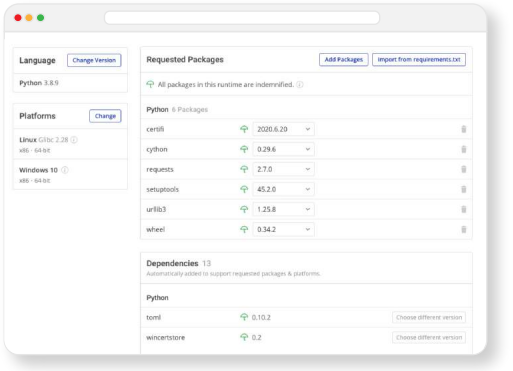How To Install A Package In Python Using Pip
With deep roots in open source, and as a founding member of the Python Foundation, ActiveState actively contributes to the Python customs. We offering the convenience, security and support that your enterprise needs while existence compatible with the open source distribution of Python.
Download ActiveState Python to get started or contact us to learn more nearly using ActiveState Python in your organization.
Near Python packages are now designed to be uniform with Python'south pip package managing director. Only if you accept a package that is not compatible with pip, yous'll need manually install Python packages. Here's how.
Python Installation Checklist
Before installing any parcel, yous should e'er ensure that a Python installation containing the necessary files needed for installing packages is in place by post-obit the Installation Requirements .
Packages That Cannot be Installed with Pip
Preliminary Steps to have:
- Download the parcel and extract it into a local directory.
- If the bundle includes its ain set of installation instructions, they should be followed. Otherwise, the most common method for manually installing a package is to implement setup.py .
Installing Python Packages with Setup.py
To install a parcel that includes a setup.py file, open up a control or terminal window and:
- cd into the root directory where setup.py is located
- Enter: python setup.py install
Setup.py Build Environment
Packages installed with setup.py take build requirements that developers must adhere to. However, some requirements are optional.
Examples
- Ensure that an upward-to-date version of setuptools is installed:
python -m pip install --upgrade setuptools - Include install_requires keyword arguments in setup.py. install_requires is a setuptools setup.py keyword used to specify minimum package requirements. For example:
install_requires=[' <packagename> '], # Optional keyword
Consummate package build requirements for a setup.py based installation are outlined past PyPA (Python Packaging Authority) in 'Sample Project'.
Sample Project
Sample Project is a template package with a setup.py file for manual installation of a packet. The file is annotated with comments for customizing the script, and for the overall package build environment. [https://github.com/pypa/sampleproject ]
Sample Project is based on the setuptools package: "A setuptools based setup module." https://github.com/pypa/sampleproject/blob/principal/setup.py ]
setup.py is the build script for packages built with setuptools.
Setup.py Example (Non-Annotated)
import setuptools with open("README.md", "r") as fh: long_description = fh.read() setuptools.setup( proper noun="<template-package-username>", # Replace with your username version="one.0.0", author=" <authorname> ", author_email=" <authorname@templatepackage.com> ", description=" <Template Setup.py bundle> ", long_description=long_description, long_description_content_type="text/markdown", url=" <https://github.com/authorname/templatepackage> ", packages=setuptools.find_packages(), classifiers=[ "Programming Language :: Python :: three", "License :: OSI Approved :: MIT License", "Operating Organization :: OS Contained", ], python_requires='>=3.half-dozen', )
How ActiveState Can Help
ActiveState provides a unified cross-platform toolchain for modern Python parcel management. It can replace the complex and hard-to-maintain in-house solutions built from multiple packet managers, environment management tools and other solutions.
By adopting the ActiveState Platform, developers tin:
- Automated building of packages from source, including link C libraries without the need for a local build environment.
- Automatic resolution of dependencies (or suggestions on how to manually resolve conflicts), ensuring that your environment always contains a set of known good dependencies that work together.
- Cardinal management of a single source of truth for your surround that tin can be deployed with a single command to all development and CI/CD environments, ensuring consistent reproducibility.
- Automatic installation of virtual Python environments on Windows or Linux without requiring prior setup.
- The ability to find, fix and automatically rebuild vulnerable environments, thereby enhancing security and dramatically reducing time and try involved in resolving CVEs.
- Visually seeing which versions of which packages are approved for utilise, thereby taking the guesswork out of evolution.
Those that prefer to work from the command line can leverage the ActiveState Platform's CLI, the Country Tool, which acts as a universal package managing director for Python, and provides access to about of the features offered by the Platform.
Modern Python Bundle Management
ActiveState provides a unified cantankerous-platform toolchain for modern Python package management. Information technology tin can supplant the complex and hard-to-maintain in-house solutions built from multiple package managers, environment management tools and other solutions.
By adopting the ActiveState Platform, developers tin can:
- Increase the security of Python environments
- Better the transparency of your open source supply chain
- Dramatically reduce bundle and surroundings management overhead
- Eliminate dependency hell
- Reduce "works on my machine" issues
Ultimately, developers that are willing to adopt the ActiveState Platform volition spend less time wrestling with tooling and more time focused on doing what they practice best: coding.
To try the ActiveState Platform for yourself, sign-upward for a free account.
Recommended Reads
How to Install Python Packages using a Script
How to Update All Python Packages
Source: https://www.activestate.com/resources/quick-reads/how-to-manually-install-python-packages/
Posted by: rivasyountwo.blogspot.com



0 Response to "How To Install A Package In Python Using Pip"
Post a Comment